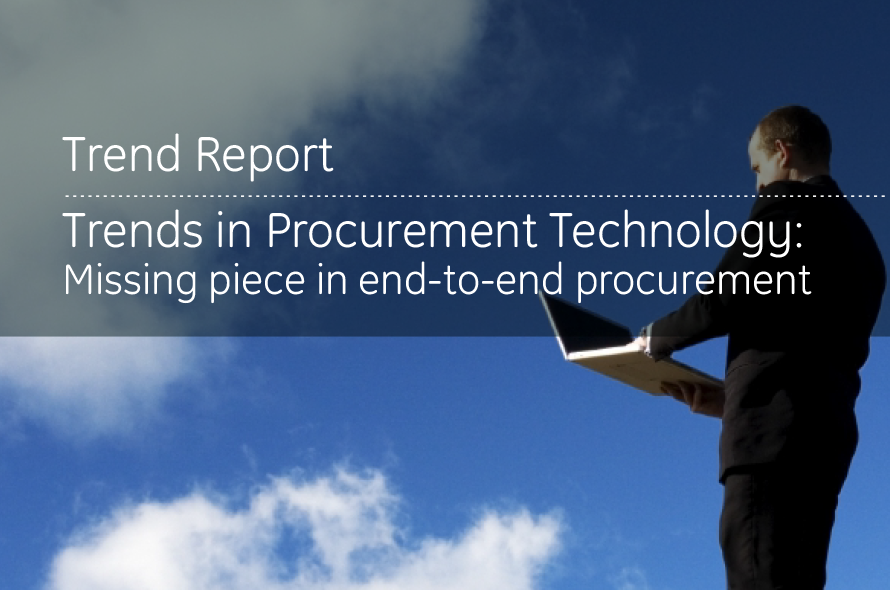Technology continues to transform the sourcing and procurement space, helping CPOs maximize efficiency and automate mundane tasks. Early adoption of procurement technology has helped firms reduce overall costs and catalyze internal process optimization. Irrespective of their size, procurement organizations can benefit from this technology revolution, especially in light of efficiencies garnered by Cloud Computing.
What is e-Procurement?
E-procurement is the electronic implementation of the procurement cycle that covers steps from spend analysis, identifying requisitions and setting up contracts with suppliers to the actual purchasing of products and evaluation of these suppliers. Studies indicate that procurement technology has helped professional consultants significantly reduce the time spent on completing procurement cycles by an average of 40 per cent. Traditionally without the help of exhaustive technology applications, a procurement cycle took approximately five months for a sole category. In the past 10 years, the influx of technology automated many aspects of the process and helped simplify labor-intensive tasks, while shortening the cycles down to about three months.
Over the years, procurement departments have found the need to simplify processes and technology. While CPOs have had access to a host of applications, most of these solutions have been fragmented. Dominant 2 market players have traditionally focused on the P2P arena; some other solution developers targeted various other stages of the procurement cycle, such as contract management tools, spend analysis tools, and requisition tracking tools. While each tool was separate and only focused on a specific functionality, the solutions were fairly generic to fit all industries.
Early adopters have benefited from e-procurement applications (Figure 1), according to Aberdeen Group's latest survey in November 2010. But the survey also points out that only 18 per cent out of a total of 156 firms have been using e-procurement for over eight years. Up to 22 per cent have used it for between five to eight years and 24 per cent have not initiated the adoption. This illustrates that e-procurement adoption is in the growth stage.
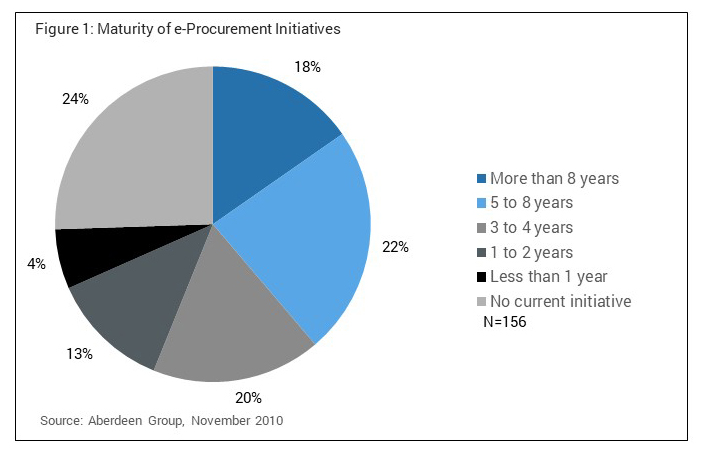
Challenges with Current Technology
With disparate technology for each function, multiple procurement technologies need to be integrated for a complete procurement cycle. This leaves loopholes in the cycle, resulting in a non-centralized and inefficient system. More often, volumes of data have to be extracted and re-entered from one module to another, which is a fairly labor-intensive process. The gaps between each phase also make the process more susceptible to errors. Hence, more manpower is needed to track status and verify data. These factors are all reflected in Aberdeen Group's November 2010 survey.
For any process, non-compliance with procedures limits its effectiveness. Stakeholder support is, therefore, essentially intrinsic to the success of procurement technology to capture the majority of spend. As illustrated in Figure 2, 28 per cent of the respondents are reluctant to adopt installed e-procurement technology. Existing market-ready technology offerings are fairly fragmented, making it cumbersome for stakeholders to adopt all the modules and learn how to use them. This leads to confusion over policies and requirements in buying, which another 28 per cent of respondents claimed to be an obstacle to eprocurement. It is fathomable that stakeholders are not always in favor of the introduction of these tools. Instead of making their lives simpler, the tool consumes more time and is often problematic to use. This results in minimal spend data captured in these tools, which, according to Figure 2, the highest number of respondents, 36 per cent, thought was the top action to address.
Furthermore, to encourage enterprise-wide acceptance, most solutions providers are migrating their applications to the Cloud space, from where they can be readily deployed and accessed by clients with authorization, over the Internet.
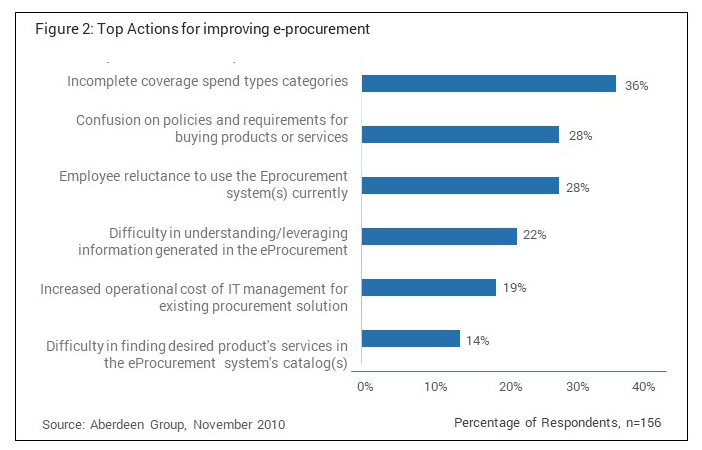
Upcoming Trends
Major players in the industry are moving towards a full service end-to-end procurement suite. Consolidation within the procurement technology space is driving larger companies to acquire smaller solutions and integrate offerings in favor of a more holistic solution, as opposed to developing a platform for their own module. This is, again, evident from the November 2010 Aberdeen Group survey, where share of standalone solutions has decreased from 16 per cent to just under 1 per cent.
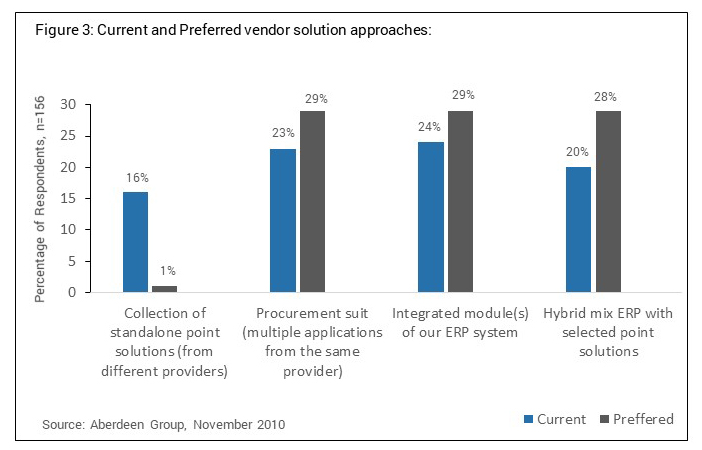
End-to-End Functionality
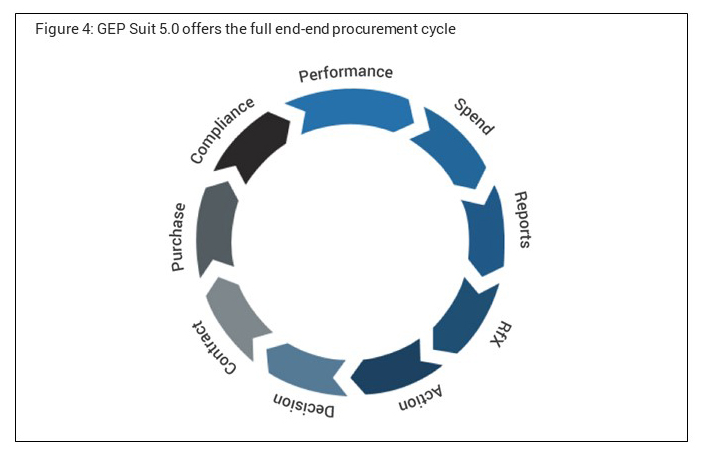
An integrated procurement cycle offers a seamless flow of procurement modules shown in Figure 4. The continuous flow of procurement activities increases organizational efficiency. Information is passed from module to module electronically, which saves employees from having to manually manage and input data points into the system.
This has several benefits for the enterprise:
- Generates savings by reducing intensive labor tasks; employees can focus more time on strategic issues.
- Improves compliance tracking and elimination of maverick spending by ensuring seamless transfer of data; an increased volume and accuracy of data is captured.
- Increased savings, improved spend visibility, increased managed spend
A traditional approach to procurement transactions would imply re-entering data in multiple modules and verifying it to ensure accuracy and validity. Today, through advances in technology and more streamlined processes, procurement departments are able to reduce labor-intensive tasks and achieve an average of 30 per cent savings on human capital. Employees now have the bandwidth to work on more strategic tasks that add more value to the company. Automatic verification of terms and conditions in a centralized procurement system improves compliance. Every step of the process is tracked and time-stamped by an automated system, optimizing visibility and transparency. A more meticulous tracking process for control over demand and spend, along with a more exhaustive and userfriendly catalog for purchases, will encourage buyers to purchase through the system within contracted pricing terms and from preferred vendors, reducing the amount of maverick spending. Ultimately, this will grant upper level management and procurement teams better visibility into the company's spend, which will improve strategic spending efforts, shorten inventory cycles and better control budgets, thus contributing to increased savings across all categories.
Finally, an end-to-end procurement technology suite will enhance client and supplier collaboration. Through auditing and tracking of the process, clients gain visibility into the suppliers' performance, and are better informed about supplier deliverables versus expectations, and whether a corrective action plan needs to be implemented. Data accessibility is optimized thorough an end-to-end solution for both suppliers and clients, providing a platform for communication to be transferred quickly and in an organized fashion. Such transparency will allow the client to obtain more value from the supplier and flag miscommunications to resolve disputes faster. Furthermore, upper level management will be able to track the number of suppliers and spend easily. With information transmitted and shared within the various modules, one can easily determine a strategic roadmap to best in class procurement and determine whether supplier consolidation is required.
Migrating to the Cloud
The advent of Cloud technology has driven procurement software providers to adapt their products to web-based applications. As mentioned before, in the case of packaged solutions, off-the-shelf programs are rigid in capabilities, and are not readily upgradable. Since products on the Internet are expected to be more flexible, to allow for easy access and frequent updates, some of these ready-made applications are having a hard time keeping up. Many of the offline tools would have to undergo a fundamental change to their program structure. The majority of strong players in today's market are the ones with home-grown solutions built for the web, and not adapted to the web.
Enterprise-Wide Acceptance
Technology is capable of making a process fairly efficient; however, the complexity and sophistication of many current tools require upfront, rigorous training time that may discourage stakeholders from adopting change. As they face difficulty in switching their everyday practices to incorporate the tool, users opt not to use the technology suite. Without the compliance of stakeholders and acceptance, the tool will not be able to capture the majority of spend and procurement activities that take place within the enterprise. As a result, its capability is undermined. The lack of data points suggests that information reflected in the tool will not completely represent enterprisewide spend, and any analysis resulting from the tool will not be holistic and accurate.
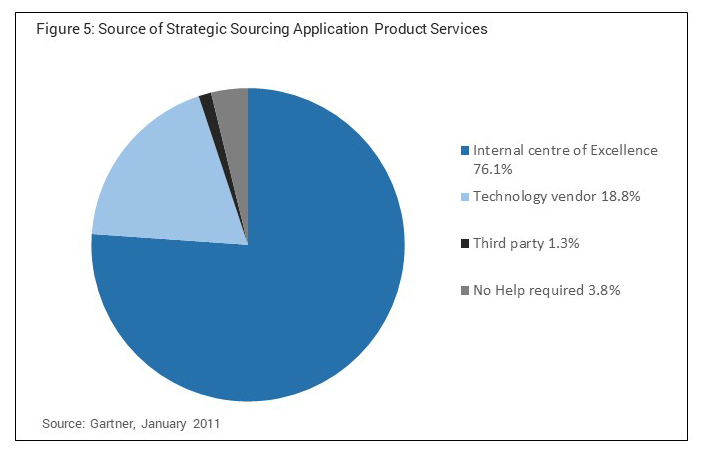
Every procurement department has its own practices and work flows. “One size fits all” applications are unable to capture what the enterprise needs, and will result in stakeholders finding loop-holes while carrying out the process offline. According to a Gartner report titled “Best Practices for Choosing, Implementing and Using E-Sourcing Solutions”, dated January 7, 2011, 96 per cent of references from 2010 Magic Quadrant for Strategic Sourcing Application Suites indicated that there is a formal source of services to help users configure the application. Without business services to help users configure the tool and align tool functionalities to organizational strategy, productivity rates and adoption levels will continue to suffer.
A technology suite that is simple to use, requires minimal training, and is configurable to the enterprise's business practices will naturally be more widely accepted by stakeholders, which will address one of the challenges indicated in Figure 2. As a result, this will allow users to reduce the amount of time spent on labor-intensive work, rectifying manual mistakes, and capturing functionalities that stakeholders desire. The change should not be so drastic that stakeholders have to change their daily routine, it should be such that a minor tweak enables users to adjusted in no time.
The Missing Piece
Upgrading offerings to the end-to-end Software-as-aService (SaaS) model and migrating to the Cloud has made procurement technology much more efficient. So why do enterprises not adopt procurement technology? Ultimately, a tool is just a tool -- compliance and stakeholder acceptance is required for the tool to be effective in its role in procurement. The majority of existing tools offer stakeholders no incentive to change their current practices. The lack of functional expertise in these applications adds no further strategic benefits to the procurement process.
Functional Expertise
Functional expertise is the area in which a technology suite can ultimately add the most value; however, it is also the most challenging objective to accomplish. Capabilities of current tools simply make the procurement process more efficient by replacing the labor-intensive work. But functional expertise is accumulated through historical experience in sourcing categories and knowledge in the procurement industry.
Consulting firms are often hired to conduct strategic projects for their category expertise. Through exercising their daily consulting efforts, consultants offer functional expertise in three different ways:
Cumulated functional database:
Having sourced a broad range of categories and worked with different suppliers, consultants acquire invaluable specific knowledge which can make a meaningful contribution to a database.
Intellectual best practices:
Consultants can offer insight into evaluating data and conjuring sourcing plans.
Embedded sourcing and procurement best practices:
By regularly conducting sourcing drives, consultants learn the best practices to carry out a project for each category, figure out what their stakeholders need. Technology produced by sourcing experts will have best practices embedded within the tool.
By blending consulting and technology, it is possible to generate not just a computational transactional tool, but an intelligent procurement tool that automates the procurement process with a consultant's mind-set. Each stage of the procurement cycle has a unique best practice to resolve the problem. Below are some examples.
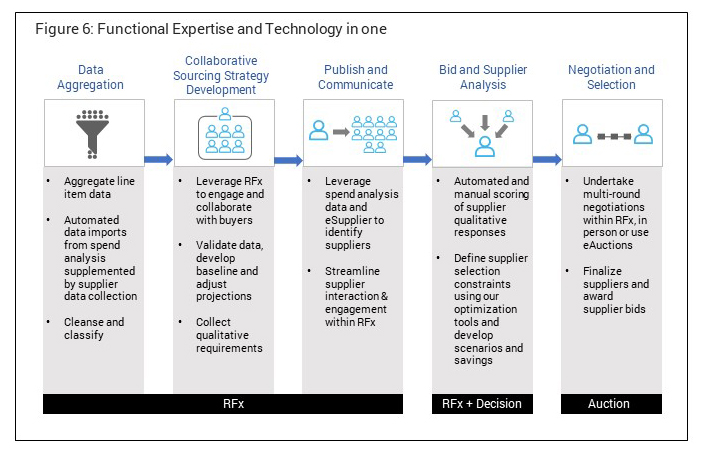
GEP Spend
Consultants understand the necessity to evaluate data across different dimensions. Procurement software should be able to capture this flexibility. To bring it to another level, technology with embedded consulting expertise should also be able to extract the spend data from the tool, and conduct an analysis on its own to determine sourcing projects. The tool should have normalized databases, reflecting consultants' experience and enabling the execution of intelligent analysis to drive results and determine savings.
By benchmarking potential saving percentages based on consulting experience, the procurement suite should be able to determine estimated savings and construct bubble charts.
GEP RFx
GEP consultants carry out the RFP process day in day out. The two major pain points many consultants would identify in the RFP process are:
- Consolidating information collected from suppliers
- Communicating and enforcing deadlines
Many current technologies provide a platform to automate the consolidation of RFPs from various suppliers. However, many consultants still choose to conduct RFPs offline through Excel sheets and e-mails. Even though the process is lengthy, and communication is often lost within the abyss of emails, the rigid timelines of the current procurement applications make the tool non-feasible. Once the deadline has passed, the creator of the RFP cannot accept any more responses. In reality, it is difficult for suppliers, and even clients, to meet rigid timelines, especially when everyone is on different time zones, and has fairly busy schedules. A procurement technology built with consulting best practices embedded within would address this by granting the flexibility with a built-in grace period that can be set by the user as desired.
Additional value that could be offered in the RFP technology module would comprise templates and a question bank, both generic and category-specific, that covers questions commonly asked when conducting RFPs. This will give users the expertise of consultants; it also provides them insight into sourcing categories without hiring external help. Stakeholders will be able to implement metrics that consultants use to assess the capability and fit of a potential supplier. These metrics can then be automatically scored to assist the stakeholder in the decision-making process.
GEP Auction
Similar to GEP RFx, the GEP Auction module also has the capability to have category-specific templates. Since electronic auctions involve real time communication between suppliers to the client and bidding of line items, stakeholders should be able to visualize the trend of bidding with an auction graph, bid details and live chat with suppliers simultaneously. Many current technologies have different windows within the tool to address these issues; however, a consultant would know the benefit of a command center view that will allow the stakeholder to multitask and accomplish all that is needed on one screen. While the auction is being carried out, the stakeholder will be able to graphically visualize each supplier's bid, while also keeping track in real time of communication between the suppliers through a chat box. This prevents the stakeholder from missing out on any important information in the auction.
GEP Contract
As with other modules, with this module too templates can be replicated, with special word replacements to customize the contract per supplier. To achieve the desired level of compliance, each transaction can go through authoritative approval. This prevents overspending and ensures that no contracts are signed without higher level management consent. However, the true value that can be added in a contract management module is the ability to alert contract owners when contracts are about to expire. A visual graphic view of the status of each contract on a chart will give stakeholders an idea of what contracts are about to expire, and whether a sourcing initiative can be adopted for a specific category. In addition, the contract management tool should separate each purchase. This feature will allow easy transfer of data to other modules, which will enable stakeholders to take advantage of end-to-end procurement technology.
GEP Supplier
As they have to conduct multiple sourcing projects, consultants work with many suppliers, and learn who the best in the industry are. With GEP's product category expertise, we have compiled a list of 35 million suppliers. This offers our clients insight on which suppliers are the most appropriate to invite to their RFP for their specific categories. The supplier management tool should maintain the list of suppliers that the enterprise conducts business with. However, the tool should go beyond the tracking of suppliers; it should also facilitate the process of supplier performance evaluation. In order to optimize value from suppliers, performance should be measured to ensure that they are adhering to the prices and services agreed to in the contract. A metric question bank and templates with recommended question/criteria ratings can be created to offer clients category-specific best-inclass metrics. Evaluation should be done automatically, with results presented in a comprehensive visual report.
GEP Purchase
When implemented correctly, the purchasing module could be the key to ensuring compliance with the procurement tool. An easy to use purchasing application, with an Amazon-like interface sorted by categories, will encourage stakeholders to buy the tool from preferred suppliers, instead of searching for parts elsewhere and engaging in agreements offline. This will not only promote compliance, but will also aid the tracking of spend. Again, line item data and price agreements can be exported into the purchasing module, and data for the module can then be exported easily to other modules of the tool efficiently to support seamless flow of end-to-end procurement.
GEP Reports
Even though an end-to-end process can push data from module to module, the data is not very useful if it cannot be extracted in a comprehensive manner. Many consultants make a living creating reports and presenting data to clients. Stakeholders are busy; they have no time to look through lengthy reports, searching for relevant data. Consultants understand what clients need to know, and present the data visually, so the key points are communicated effectively. Since stakeholders will have a better idea of the situation, this will motivate stakeholder buy-in on the sourcing projects that need approval.
With the philosophy of marrying Technology and Consulting, GEP is able to take advantage of its accumulated functional expertise and integrate the knowledge into its very own technology suite. GEP's business model focuses around client delight; in view of interacting day-to-day with our clients, we know what they need. Our tool is created by sourcing people for sourcing people; consultants use the tool, provide feedback, and make recommendations, highlighting best practices and their sourcing expertise, which are then embedded into the tool. With the incorporation of category expertise into our highly automated endto-end tool that is configurable to each enterprise's business, we answer our clients' needs and present them with a mechanism to efficiently carry out their procurement process – from start to finish.

